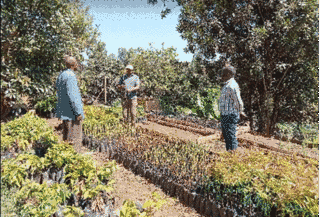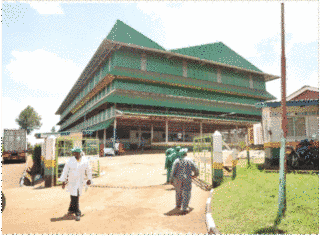The sites for the field visit
All the sites are within 100 Km from the conference venue. They are all located in the central highlands of Kenya which experience high to moderate rainfall and generally good climatic conditions for agriculture and forestry. The two cooperatives (Lima Linda and Agrifrunuts Cooperatives) which were established for purposes of enabling farmers’ access to better export markets are located on a hilly landscape which is mainly composed of small farms averaging about 1-2 acres. Kakuzi PLC is located at a flatter landscape with many plantations.
Lima Linda Marketing Cooperative in Gatura Muranga

Lima Linda Marketing Cooperative (‘LLMC’) was formed and registered in 2019 by Avocado farmers from Muranga county. This was after two different groups came together to register the cooperative with an initial membership of 55. The cooperative has since grown to 1457 members (728 male, 582 female and 147 youth) by the end of 2022. The cooperative was able to sell 135 tons of avocado at Kshs.9,500,000 (USD 76,600 at current market rates) in 2022.The cooperative is managed by a committee of 11 members which oversee the operations and activities of the cooperative with a physical office at Gatura town. The Core mandate of Lima Linda cooperative is to bring together avocado farmers and other practitioners within Muranga county and mainly Gatanga Sub location for a common front in collective marketing of Avocados and other forestry products apart from advocating for a favorable business environment and empowerment through linkages and partnerships. The interventions will eventually lead to achieving the cooperatives’ goal of being “A leading farmer group in envisioning a wealthy community living in a clean and healthy environment with food security.”
The cooperative strives to achieve this vision through promoting commercialization of farm forestry through empowerment of its members and linkage to better marketing companies offering competitive prices and services and cooperative development. Through collective sale of avocado, the cooperative is able to meet its operation costs from the commission from the sales through the cooperative. The cooperative has also established a model tree nursery which is a learning center for best farm practices for production of quality and certified seedlings thereby generating income for farmers and the cooperative.
The cooperative has two Village savings and loans groups (VSLA) with a total membership of 42 members. 11 members have been linked to Muungano micro-finance Bank in the last year. LLMC is a commercial arm of Central Highlands Tree Growers Association which is a member of FFSPAK. In addition, LLMC joined Muranga County Avocado Cooperative Union in 2022 so as to further benefit its members through access to services and economies of scale.
Gatundu North Agrifrunuts Cooperative Society in Ndiko, Kiambu

Gatundu North Agrifrunuts Cooperative Society (GNACS) was formed in 2016 by only 14 members from Kiambu county. The main objective was to collectively obtain better markets and prices for their forestry products especially avocado and macadamia as well as sourcing extension services. The cooperative has since grown in membership of 88 active members (47 males,24 female and 17 youths) with a total avocado sale of Kshs.422,400 (USD 3,500 at current rates) in 2022.Through the cooperative, the members are also able to receive extension services on better farm practices, quality management of products and resource mobilization for the cooperative. The cooperative has established model tree nursery as a learning center for the community as well as an income generating activity for the cooperative. GNACS intends to continue growing to achieve the members vision of “increased members incomes through value addition of farm products”. This can be achieved through commercialization and marketing of value-added products through the cooperative farm products. The cooperative has a strong village savings a loans (VSLA) model. This is a model used by farmers to save little amount of money among themselves and use the fund to boost small businesses inform of loans and repays after an agreed time period.31 members have formed a VSLA group and 15 members have been linked to TAI SACCO in the last year. Agrifrunuts Cooperative is also a marketing arm for Central Highlands Tree growers Association.
Kijabe Environment Volunteers (KENVO) in Lari, Kiambu

Kijabe Environment Volunteers (KENVO) is a community-based organization engaged in developing sustainable nature conservation programs in the Kikuyu Escarpment Forest. KENVO was formed in 1994 and officially registered in 1996. The major goal of KENVO is to promote conservation of the Kikuyu Escarpment ecosystems, while supporting community livelihoods. KENVO works in a number of key areas including capacity building, forest restoration, youth empowerment, promoting ecotourism, and research.
KENVO has helped improve the livelihood of communities, reduce threats on biodiversity and develop youth leadership. It collaborates with key stakeholders such as government departments, research institutions, private sector, and other development agencies to inform, educate and build the capacity of communities to embrace appropriate conservation practices in a sustainable way. It also works with the communities surrounding the forest in tree planting initiatives. In 2022, more than 800 farmers were supported to grow avocados on their farms for commercial and nutritional purposes.
Objectives of KENVO
- To raise community awareness on the value and importance of the local forests, biodiversity and other natural resources through environmental education and awareness campaigns.
- To initiate and promote both rural development and environmental-friendly income-generating activities that link community survival to environmental conservation.
- To gather information through research on local natural resources and traditional knowledge that augments scientific work in biodiversity conservation.
- To ensure that the local forests’ rich biological diversity is conserved with strong support and active participation from the local communities.
Gachege Tea Factory

Commissioned in 2002/03 to manufacture Black C.T.C. tea with an annual installed processing capacity of 15,000,000 Kgs green leaf, Gachege factory catchments area has a total of 4,917 registered growers with a total of 1,028.9 Ha under tea. Gachege tea factory falls within KTDA administrative Region I and is located in Kiambu County. It is located 40 kms off Thika superhighway towards Naivasha via Mangu, Gakoe highway and about 77 Kms from Nairobi. The factory is on relatively high altitude of 1,750-2,150 M above the sea level.
Currently, the factory serves 4,917 growers with 10,559,390 tea bushes with a potential area of 1028.8 Hectares of land. The catchment comprises of mainly two agro-ecological Zones, namely Lower Highlands bordering the Aberdare Forest on the upper side and upper medium lands bordering with marginal areas on the lower side. Temperature ranges from 28 degrees C to 14 degrees C and Rainfall of -1260MM/ annum. Soils are fairly deep and red-brown volcanic.
The factory has established an environmental green program where indigenous tree seedlings are provided to the farmers in efforts to protect the Aberdare water towers and the surrounding environment. It also provides treated water to the surrounding community. The factory has a forest for sustainable fuel wood harvesting but mostly relies on fuelwood sourced from the local community to process its tea.
Key issues to be addressed (Checklist)
The table below presents key questions that will be addressed during visit to the different sites.
Kiambu County | Muranga County | Kijabe Environment volunteers (KENVO) |
How are producers organized/benefiting from carbon financing? What self-financing mechanisms are available to members-VSLA’s? Has collective marketing through cooperatives afforded the FO or its members access to better financing? What is the role of Savings and Credit Cooperatives in providing financial services to farmers? Income generating Activities/initiatives as a means of financing FO operations. What model is used to pay farmers? Does it allow farmer the ability to plan and invest better in their enterprises? | How are producers organized/benefiting from carbon financing? What self-financing mechanisms are available to members-VSLA’s? Has collective marketing through cooperatives afforded the FO or its members access to better financing? What is the role of Savings and Credit Cooperatives in providing financial services to farmers? Income generating activities/initiatives as a means of financing FO operations. What model is used to pay farmers. Does it allow farmer the ability to plan and invest better in their enterprises? | Smallholder producers programme and benefits related to financial services access for small holder farmers Whether better market access (Export) and long-term contracts translate to better financial services access
|
Additional information
In addition to the encounter with the cooperatives, the field trip participants will be able to observe the following production, settlement and infrastructural systems that can contribute to better understanding of the setting.
- Small holder Avocado farms and households
- Meet County Extension officers.
- The cooperative offices/sites (understand the operations of the cooperatives)
- Visit model tree nurseries.
